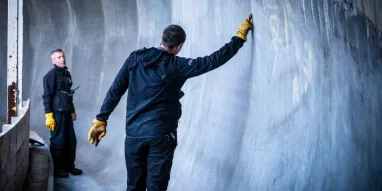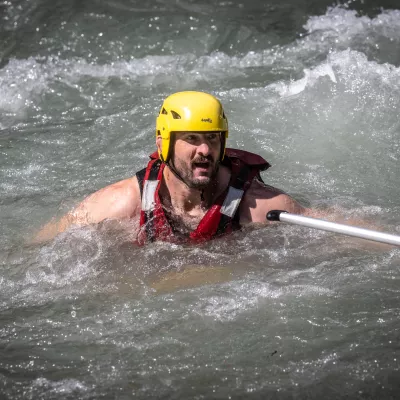If you thought that, to pilot a bobsleigh, all you have to do is let it slide from the top of the icy track to the bottom then brake like mad, you’ve got it all wrong! From the pulleys that have to be delicately handled, to the strategic line to follow and the role of the brakeman, we are going to share all the secrets of professional bobsledders with you (so that you can then put them into practice yourselves – yes, really!).
The basic element: an ultrasophisticated circuit of concrete and ice
A bobsleigh track is a jewel of engineering: a structure made of concrete and covered in ice, equipped with kilometres and kilometres of pipes that have a cooling fluid running through them.
To keep it running, it takes a team of no less than 20 or so people who all have jobs you have never heard of, the sort you do not learn at school… From October, the refrigeration specialists start up and monitor the compressors. The ice guys spray the water (that comes from a source that cannot be used as drinking water) that will turn into ice, before manually planing every square centimetre with a scraper until the track is perfectly smooth and profiled.

A few numbers:
- France’s one and only bobsleigh track! (7 in Europe, 13 worldwide)
- Commissioned in 1992 for the Albertville Olympic Games
- 1,507.5 m long
- 90 km of pipes to refrigerate the concrete
- 6,800 m² surface area to cover with ice
- 2 to 40 cm thickness of ice depending on areas of the track
- Temperature of the ice: -0.5°C at the surface
Steering? It’s all in the fingertips!
Just like in the cult film ‘Cool Runnings’, ‘Feel the rhythm! Feel the rhyme’ Get on up, it’s bobsled time!’: a competition bobsled has to be steered. You can’t just give it a good shove at the start and then let it slide down and hope to get a good time.
The pilot’s fingers play an essential role. Like paragliding (or horse riding…), they control the trajectory via a control system: simple pulleys connected to directional runners at the front of the bob. Both strength and precision are therefore needed to pull just the right amount to the right or left and keep the bobsled on the best line of the track for picking up speed.
That might sound easy, but not so much when you know that a bob can reach 120 km/h (the Bob Racing speed record on the La Plagne track? 134 km/h!). You really need to stay on your toes. 'Become a bobsleigh pilot in a day’ courses are scheduled for winter 24/25.
The secret of the best pilots: a little instinct and a lot of strategy
The bobsleigh track in La Plagne has 19 raised bends that follow one another at breakneck speed down its 1,500 m length and 124.5 m altitude drop (i.e. an average gradient of 8.29%). Needless to say, you wouldn’t want to set off without doing a thorough reconnaissance first.
In bobsleigh jargon, this is called a ‘track walk’. With crampons on their feet, the bobsled team study every bend and every transition, mentally rehearsing the movements they will need to make at top speed to follow the best line, limit friction and pick up speed.
Bobsledding is a combination of very detailed technical knowledge as well as experience and feeling. Why? Because decisions have to be made at lightning speed and because our bodies are capable of acting even before the brain has time to think!
- Would you like to see a pilot in action? Why not try a Bob Racing descent? As the passenger, you won’t have to worry about steering or braking… Which is great because it isn’t easy to think when you have up to 3g of centrifugal force pressing down on your head!
- Would you prefer to work on your own descent strategy? You can study the La Plagne bobsleigh track, then put your observations into practice down the last 7 bends when you participate in a pilot’s course! Sessions are programmed for the winter season 24/25, book your place now.
3 essential qualities: concentration, precision… and commitment!
Choosing (and staying on) the best possible line requires top technical quality from the bobsleigh pilot, as well as unfailing commitment! That’s what it takes to climb the bends at over 100 km/h and allow the team to snatch those few hundredths of a second that will make the difference between being on the podium or only winning a chocolate medal.
The bobsled pros train regularly on La Plagne’s Olympic Bobsleigh track to hone all these essential skills and perform well at international competitions. The dream for French bobsledders is, of course, to win a medal on their home track at the 2030 Olympic or Paralympic Games!
If you want to test how cool you are, you can try to beat the clock on the last 7 bends of the La Plagne bobsleigh track during one of our ‘Become a bobsleigh pilot in a day’ courses! Previous participants have reached average speeds of 80 km/h… Can you beat that?

How about if you don’t scare easily… but your sense of direction isn’t the best either? No problem: jump aboard a Bob Raft, a self-driving, self-braking machine that will do all the hard work for you down the 1,500 m of the icy track (top speed: 80 km/h!).
No bobsleigh pilot is without their brakeman
This probably did not escape your attention during the Olympic Games (or while you were watching ‘Cool Runnings’…): there is a whole team in a bobsleigh. A pilot (at the front) and a brakeman (at the back) in a 2-man bob, with two additional pushers in a 4-man bob.
The whole team helps to push for the first 15 metres, before sliding into their seats as smoothly and rapidly as possible. Throughout the descent, the pilot manages the controls while the pushers move very slightly to the left or right to optimise weight distribution and keep the bob going down the right line.

The brakeman only pulls on the brakes after crossing the finish line! That is when the back runners show their ‘teeth’ (literally) to grip the ice and bring the ‘rocket’ to a halt.
A few numbers (in competition):
- Length of a 4-man bob: 3.80 m maximum
- Width: 67 cm maximum
- Weight: 630 kg maximum, including the athletes
It’s over to you! Take it in turns to be the pilot, then the brakeman during a pilot’s course organised during the winter season 24/25, under the guidance of professional bobsledders.
So what happens during the one-day course?
- Morning: a briefing and a track walk with a professional pilot to see each of the bends and choose the line you want to take when you are in the bob
- Lunchtime: lunch in the Salle Panoramique at the Bobsleigh track and pairing up
- Afternoon: loading the 2-man bobsleighs, getting ready at bend 12 (i.e. 7 bends from the finish line)… and off you go! You will do two descents: one as the pilot, the other as the brakeman.
✨ Book your place now (minimum age 16) | Only 3 sessions are scheduled during the winter season 24/25.












